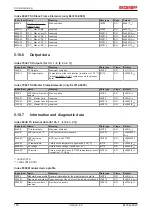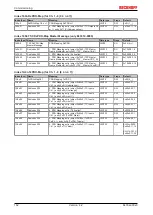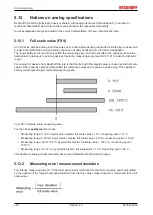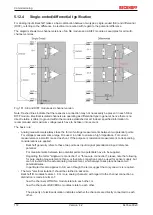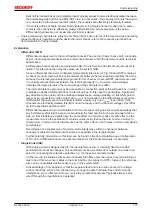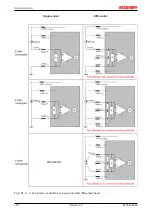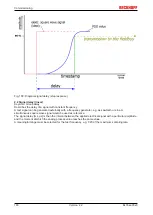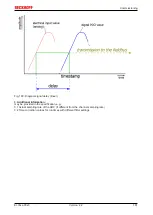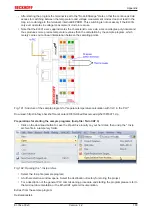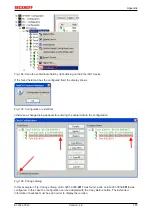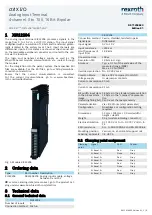
Commissioning
EL33xx-00x0
173
Version: 4.2
◦ Beckhoff terminals/ boxes (and related product groups) always feature electrical isolation between
the field/analog side and the bus/EtherCAT side. In other words, if two analog terminals/ boxes are
not connected via the power contacts (cable), the modules are effectively electrically isolated.
◦ If channels within a module are electrically isolated, or if a single-channel module has no power
contacts, the channels are effectively always differential. See also explanatory notes below.
Differential channels are not necessarily electrically isolated.
• Analog measuring channels are subject to technical limits, both in terms of the recommended operating
range (continuous operation) and the destruction limit. Please refer to the respective terminal/ box
documentation for further details.
Explanation
•
differential (DIFF)
◦ Differential measurement is the most flexible concept. The user can freely choose both connection
points, input+/signal potential and input-/reference potential, within the framework of the technical
specification.
◦ A differential channel can also be operated as SE, if the reference potential of several sensors is
linked. This interconnection may take place via the system GND.
◦ Since a differential channel is configured symmetrically internally (cf. Fig. SE and DIFF module as
2-channel variant), there will be a mid-potential (X) between the two supplied potentials that is the
same as the internal ground/reference ground for this channel. If several DIFF channels are used
in a module without electrical isolation, the technical property V
CM
(common-mode voltage)
indicates the degree to which the mean voltage of the channels may differ.
◦ The internal reference ground may be accessible as connection point at the terminal/ box, in order
to stabilize a defined GND potential in the terminal/ box. In this case it is particularly important to
pay attention to the quality of this potential (noiselessness, voltage stability). At this GND point a
wire may be connected to make sure that V
CM,max
is not exceeded in the differential sensor cable.
If differential channels are not electrically isolated, usually only one V
CM, max
is permitted. If the
channels are electrically isolated this limit should not apply, and the channels voltages may differ
up to the specified separation limit.
◦ Differential measurement in combination with correct sensor wiring has the special advantage that
any interference affecting the sensor cable (ideally the feed and return line are arranged side by
side, so that interference signals have the same effect on both wires) has very little effect on the
measurement, since the potential of both lines varies jointly (hence the term common mode). In
simple terms: Common-mode interference has the same effect on both wires in terms of amplitude
and phasing.
◦ Nevertheless, the suppression of common-mode interference within a channel or between
channels is subject to technical limits, which are specified in the technical data.
◦ Further helpfully information on this topic can be found on the documentation page
Configuration
of 0/4..20 mA differential inputs
(see documentation for the EL30xx terminals, for example).
•
Single Ended
(SE)
◦ If the analog circuit is designed as SE, the input/reference wire is internally fixed to a certain
potential that cannot be changed. This potential must be accessible from outside on at least one
point for connecting the reference potential, e.g. via the power contacts (cable).
◦ In other words, in situations with several channels SE offers users the option to avoid returning at
least one of the two sensor cables to the terminal/ box (in contrast to DIFF). Instead, the reference
wire can be consolidated at the sensors, e.g. in the system GND.
◦ A disadvantage of this approach is that the separate feed and return line can result in voltage/
current variations, which a SE channel may no longer be able to handle. See common-mode
interference. A V
CM
effect cannot occur, since the module channels are internally always 'hard-
wired' through the input/reference potential.
Summary of Contents for EL33-00 Series
Page 2: ......
Page 6: ...Table of contents EL33xx 00x0 6 Version 4 2...
Page 17: ...Product overview EL33xx 00x0 17 Version 4 2 Fig 10 EL3312 Fig 11 EL3314...
Page 18: ...Product overview EL33xx 00x0 18 Version 4 2 Fig 12 EL3314 0002 Fig 13 EL3314 0010...
Page 61: ...Mounting and wiring EL33xx 00x0 61 Version 4 2 Fig 45 EL3314 0010 Fig 46 EL3314 0090...


